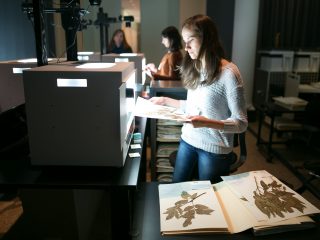Digitizing Herbarium Specimens
Matthew C. Pace, Ph.D., is an Assistant Curator at The New York Botanical Garden.
In our Steere Herbarium, a combination of capturing ultra high-resolution images of specimens and entering detailed information about each specimen in a searchable database is making this scientific collection easily available to anyone with an internet connection. Among other benefits, this online resource will help researchers overcome the acute problem of access to specimens of threatened and endangered species. Deeper understanding of the various adaptations of the species and their evolution will make it possible to design better conservation and management strategies. The public’s interest in these charismatic and captivating plants also affords an opportunity to engage students and teachers in discussions about biodiversity and its preservation, plant adaptations, and mutually beneficial species relationships. Additionally, the availability of two million digitized records will enhance the education and enjoyment of citizen scientists, horticultural hobbyists, and other non-academic enthusiasts.
combination of capturing ultra high-resolution images of specimens and entering detailed information about each specimen in a searchable database is making this scientific collection easily available to anyone with an internet connection. Among other benefits, this online resource will help researchers overcome the acute problem of access to specimens of threatened and endangered species. Deeper understanding of the various adaptations of the species and their evolution will make it possible to design better conservation and management strategies. The public’s interest in these charismatic and captivating plants also affords an opportunity to engage students and teachers in discussions about biodiversity and its preservation, plant adaptations, and mutually beneficial species relationships. Additionally, the availability of two million digitized records will enhance the education and enjoyment of citizen scientists, horticultural hobbyists, and other non-academic enthusiasts.
The National Science Foundation (NSF) offers the Advancing Digitization of Biodiversity Collections program, funding specimen digitization efforts at natural history museums through multi-institution partnerships called Thematic Collections Networks (TCN). The Garden has a long history of involvement in this program, leading or participating in seven current and past TCNs.
Plants that are carnivorous, epiphytic, and/or succulent are often critically endangered, yet there is little focused digitized specimen data available to help scientists design meaningful conservation protocols, or study how such fantastically unusual species evolved. The lack of such digital data severely curtails the types of questions that researchers can ask, and limits opportunities for engagement between the scientists who study these remarkable plants, and the hobbyists who enjoy growing them. By partnering with 17 other institutions with large holdings of carnivorous, epiphytic, and/or succulent plants, this TCN will help to fill that void. Additionally, Drs. Thiers and Pace recognized an opportunity for the Garden to lead the collections community in a discussion about how to ethically share data of these imperiled plants. Currently, there is no unified approach as to how to share digitized data of endangered or otherwise rare species within the natural history museum community.
The scientists who study plants love the species they research, and want to share these amazing organisms with the public. However, sharing information can sometimes be a double-edged-sword: by openly sharing digitized specimen data of these species, they might unintentionally hand this information to poachers or other unscrupulous collectors whose aim is profit, not scientific advancement. There are dozens of examples of rare, newly described species suddenly appearing on the black market, illegally traded much like elephant ivory, often leading to the extinction of whole populations, a worse-case scenario for a scientist. The problem encompasses rare orchids and cacti, reptiles and birds sold as pets, and even fossils. Currently, the scientific community does not have a unified approach on how to ethically share (or not share in certain cases) digitized specimen data. To address this long-standing and complex issue, Drs. Thiers and Pace will be leading a symposium at the 2020 Society for the Preservation of Natural History Collections conference. Their goal is to engage a group of leading scientists, government officials, collections managers, and hobbyist groups on this topic, ultimately producing a written community standard that can be followed by all natural history collections, striking a balance between public-oriented access, and protection of sensitive specimen information.
This article originally appeared as part of the Spring-Summer 2019 issue of Garden News, NYBG’s seasonal newsletter. For further reading, view the issue online and discover a sampling of stories about current programs and undertaking at the Garden.
SUBSCRIBE
Enter your email address to subscribe to this blog and receive updates on new posts.











